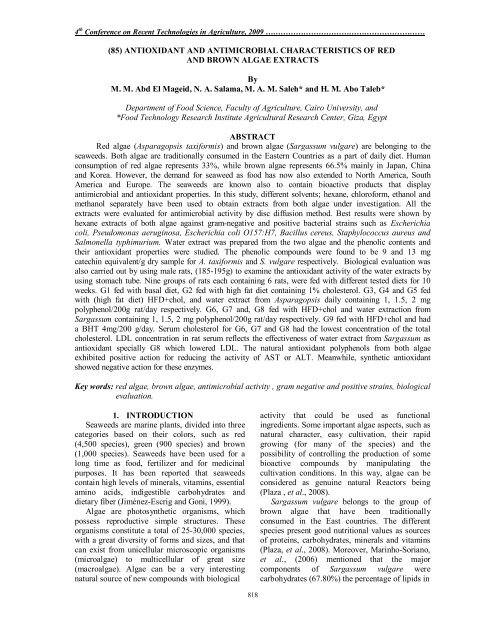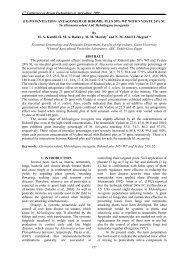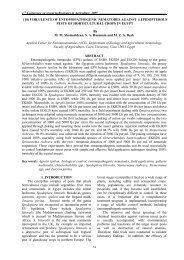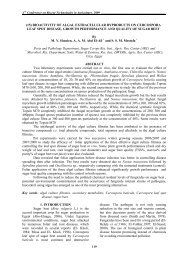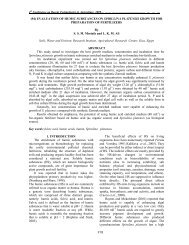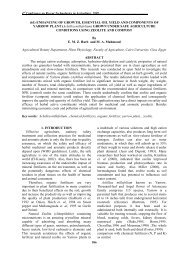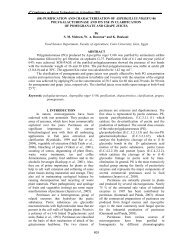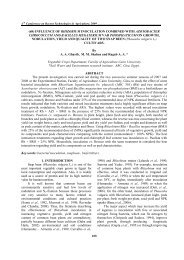antioxidant and antimicrobial characteristics of red and brown algae ...
antioxidant and antimicrobial characteristics of red and brown algae ...
antioxidant and antimicrobial characteristics of red and brown algae ...
You also want an ePaper? Increase the reach of your titles
YUMPU automatically turns print PDFs into web optimized ePapers that Google loves.
4 th Conference on Recent Technologies in Agriculture, 2009 ………………………………………………………(85) ANTIOXIDANT AND ANTIMICROBIAL CHARACTERISTICS OF REDAND BROWN ALGAE EXTRACTSByM. M. Abd El Mageid, N. A. Salama, M. A. M. Saleh* <strong>and</strong> H. M. Abo Taleb*Department <strong>of</strong> Food Science, Faculty <strong>of</strong> Agriculture, Cairo University, <strong>and</strong>*Food Technology Research Institute Agricultural Research Center, Giza, EgyptABSTRACTRed <strong>algae</strong> (Asparagopsis taxiformis) <strong>and</strong> <strong>brown</strong> <strong>algae</strong> (Sargassum vulgare) are belonging to theseaweeds. Both <strong>algae</strong> are traditionally consumed in the Eastern Countries as a part <strong>of</strong> daily diet. Humanconsumption <strong>of</strong> <strong>red</strong> <strong>algae</strong> represents 33%, while <strong>brown</strong> <strong>algae</strong> represents 66.5% mainly in Japan, China<strong>and</strong> Korea. However, the dem<strong>and</strong> for seaweed as food has now also extended to North America, SouthAmerica <strong>and</strong> Europe. The seaweeds are known also to contain bioactive products that display<strong>antimicrobial</strong> <strong>and</strong> <strong>antioxidant</strong> properties. In this study, different solvents; hexane, chlor<strong>of</strong>orm, ethanol <strong>and</strong>methanol separately have been used to obtain extracts from both <strong>algae</strong> under investigation. All theextracts were evaluated for <strong>antimicrobial</strong> activity by disc diffusion method. Best results were shown byhexane extracts <strong>of</strong> both <strong>algae</strong> against gram-negative <strong>and</strong> positive bacterial strains such as Escherichiacoli, Pseudomonas aeruginosa, Escherichia coli O157:H7, Bacillus cereus, Staphylococcus aureus <strong>and</strong>Salmonella typhimurium. Water extract was prepa<strong>red</strong> from the two <strong>algae</strong> <strong>and</strong> the phenolic contents <strong>and</strong>their <strong>antioxidant</strong> properties were studied. The phenolic compounds were found to be 9 <strong>and</strong> 13 mgcatechin equivalent/g dry sample for A. taxiformis <strong>and</strong> S. vulgare respectively. Biological evaluation wasalso carried out by using male rats, (185-195g) to examine the <strong>antioxidant</strong> activity <strong>of</strong> the water extracts byusing stomach tube. Nine groups <strong>of</strong> rats each containing 6 rats, were fed with different tested diets for 10weeks. G1 fed with basal diet, G2 fed with high fat diet containing 1% cholesterol. G3, G4 <strong>and</strong> G5 fedwith (high fat diet) HFD+chol, <strong>and</strong> water extract from Asparagopsis daily containing 1, 1.5, 2 mgpolyphenol/200g rat/day respectively. G6, G7 <strong>and</strong>, G8 fed with HFD+chol <strong>and</strong> water extraction fromSargassum containing 1, 1.5, 2 mg polyphenol/200g rat/day respectively. G9 fed with HFD+chol <strong>and</strong> hada BHT 4mg/200 g/day. Serum cholesterol for G6, G7 <strong>and</strong> G8 had the lowest concentration <strong>of</strong> the totalcholesterol. LDL concentration in rat serum reflects the effectiveness <strong>of</strong> water extract from Sargassum as<strong>antioxidant</strong> specially G8 which lowe<strong>red</strong> LDL. The natural <strong>antioxidant</strong> polyphenols from both <strong>algae</strong>exhibited positive action for <strong>red</strong>ucing the activity <strong>of</strong> AST or ALT. Meanwhile, synthetic <strong>antioxidant</strong>showed negative action for these enzymes.Key words: <strong>red</strong> <strong>algae</strong>, <strong>brown</strong> <strong>algae</strong>, <strong>antimicrobial</strong> activity , gram negative <strong>and</strong> positive strains, biologicalevaluation.1. INTRODUCTIONSeaweeds are marine plants, divided into threecategories based on their colors, such as <strong>red</strong>(4,500 species), green (900 species) <strong>and</strong> <strong>brown</strong>(1,000 species). Seaweeds have been used for along time as food, fertilizer <strong>and</strong> for medicinalpurposes. It has been reported that seaweedscontain high levels <strong>of</strong> minerals, vitamins, essentialamino acids, indigestible carbohydrates <strong>and</strong>dietary fiber (Jiménez-Escrig <strong>and</strong> Goni, 1999).Algae are photosynthetic organisms, whichpossess reproductive simple structures. Theseorganisms constitute a total <strong>of</strong> 25-30,000 species,with a great diversity <strong>of</strong> forms <strong>and</strong> sizes, <strong>and</strong> thatcan exist from unicellular microscopic organisms(micro<strong>algae</strong>) to multicellular <strong>of</strong> great size(macro<strong>algae</strong>). Algae can be a very interestingnatural source <strong>of</strong> new compounds with biologicalactivity that could be used as functionaling<strong>red</strong>ients. Some important <strong>algae</strong> aspects, such asnatural character, easy cultivation, their rapidgrowing (for many <strong>of</strong> the species) <strong>and</strong> thepossibility <strong>of</strong> controlling the production <strong>of</strong> somebioactive compounds by manipulating thecultivation conditions. In this way, <strong>algae</strong> can beconside<strong>red</strong> as genuine natural Reactors being(Plaza , et al., 2008).Sargassum vulgare belongs to the group <strong>of</strong><strong>brown</strong> <strong>algae</strong> that have been traditionallyconsumed in the East countries. The differentspecies present good nutritional values as sources<strong>of</strong> proteins, carbohydrates, minerals <strong>and</strong> vitamins(Plaza, et al., 2008). Moreover, Marinho-Soriano,et al., (2006) mentioned that the majorcomponents <strong>of</strong> Sargassum vulgare werecarbohydrates (67.80%) the percentage <strong>of</strong> lipids in818
Antioxidant <strong>and</strong> <strong>antimicrobial</strong> <strong>characteristics</strong> ……………………….……………………………………………………….left for 15 min at room temperature then the tubeswere centrifuged for 10 min at 3000 rpm <strong>and</strong> theclean supernatant serum was kept frozen at -20 ºCuntil analysis. The levels <strong>of</strong> serum cholesterol,low- <strong>and</strong> high- density lipoproteins, total lipids<strong>and</strong> triglycerides were determined according to themethod outlined by Richmond (1973) <strong>and</strong> Allainet al. (1974); Wiel<strong>and</strong> <strong>and</strong> Seidel (1983); Bursteinet al. (1970) <strong>and</strong> Lopez –Virella et al.(1977);Zollner <strong>and</strong> Kirsch (1962) <strong>and</strong> Fassati <strong>and</strong>Prencipe (1982), respectively. ALT <strong>and</strong> AST weremeasu<strong>red</strong> according to methods described byReitman <strong>and</strong> Farnkel (1957). Urea <strong>and</strong> uric acidwere determined according to the methodsdescribed by Fawcett <strong>and</strong> Soctt (1960) <strong>and</strong>Barham <strong>and</strong> Trinder (1972) respectively.The <strong>antimicrobial</strong> activity <strong>of</strong> <strong>algae</strong> extractPreparation <strong>of</strong> <strong>algae</strong> extractThe <strong>algae</strong> powder was submitted to lipidsolubleextraction with individual numeroussolvents, i. e. methanol, ethanol, chlor<strong>of</strong>orm <strong>and</strong>hexane 1:15(w: v) using a Soxhlet extractor at 55-60 ºC. All samples were refluxed for 24 h untilsaturation <strong>and</strong> the respective extracts were dried inan oven at 50 ºC <strong>and</strong> subsequently, the residualextracts were suspended in the respective solventsto a final concentration <strong>of</strong> 1mg/20µl.All microorganisms were grown on nutrientbroth, incubated at 37ºC for 24 h <strong>and</strong> plated, usinga sterile swab, onto Petri dishes containingMueller Hinton agar. At the same time, sterilediscs, <strong>of</strong> 5 mm diameter, were embedded with 20µl <strong>of</strong> the <strong>algae</strong> extracts (as the tested group) orwith the different solvent (as the control group)<strong>and</strong> added to the cultu<strong>red</strong> dishes. The toxicity <strong>of</strong>the <strong>algae</strong> extracts against microorganism wasdetermined after incubated the dishes on 37 ºC for24 h by measuring the diameter <strong>of</strong> the hole aroundthe disc. All experiments were performed at leastin duplicate.3. RESULT AND DISCUSSIONTotal phenolic contentThe phenolic compounds are one <strong>of</strong> the mosteffective <strong>antioxidant</strong>s in <strong>brown</strong> <strong>algae</strong> (Nagai <strong>and</strong>Yukimoto, 2003). Table (1) show the phenolliccompounds as mg /g dry sample in the waterextraction <strong>of</strong> both tested <strong>algae</strong> A.taxiformis <strong>and</strong> S.vulgare. It was 9 mg /g in the water extraction <strong>of</strong><strong>red</strong> <strong>algae</strong> (A. taxiformis) <strong>and</strong> 13 mg /g in the waterextraction <strong>of</strong> <strong>brown</strong> <strong>algae</strong> (S. vulgare). This resultis in agreement with those obtained by (Zahra etal., 2007).Table (1): total phenol <strong>and</strong> <strong>antioxidant</strong> activity <strong>of</strong> <strong>red</strong> <strong>and</strong> <strong>brown</strong> <strong>algae</strong>MaterialsTotal phenolsmg/g dry sampleRadical scavengingactivities( RSA ) %A.taxiformis (<strong>red</strong> <strong>algae</strong> ) 9 57 %S. vulgare(<strong>brown</strong> <strong>algae</strong>) 13 61 %BHT ---- 69 %Antioxidant activity assay (DPPH radicalscavenging activity)Result in Table (1) show also the radicalscavenging activities (RSA) for the water extract<strong>of</strong> the two tested <strong>algae</strong> (A.taxiformis <strong>and</strong>S. vulgare). The RSA% <strong>of</strong> <strong>brown</strong> <strong>algae</strong> (S.vulgare) recorded 61% that is higer than that theRSA% <strong>of</strong> <strong>red</strong> <strong>algae</strong> (A.taxiformis) that was foundto be only 57% <strong>of</strong> DPPH. This could be attributedto the amount <strong>of</strong> total phenolic compound <strong>of</strong> the<strong>brown</strong> <strong>algae</strong> that those found into the <strong>red</strong> <strong>algae</strong>.These results are in agreement with found byKuda et al., (2005). Result show also that the BHTrecorded the highest value <strong>of</strong> RSA% (69%,)however, BHT conside<strong>red</strong> as synthetic <strong>antioxidant</strong>that has adverse effects on human health. Phenolcompound <strong>of</strong> A .taxiformis <strong>red</strong> <strong>algae</strong> <strong>and</strong> S.vulgare <strong>brown</strong> <strong>algae</strong>.Table (2) shows the phenol compound <strong>of</strong> both<strong>of</strong> tested <strong>algae</strong>. Phenols were determinedquantitatively as µg /g. Both tested <strong>algae</strong> showedalmost the same concentration <strong>of</strong> phenols. Themajor identified phenol compounds were found tobe Protocatechuic, Dihydroxytyrosol <strong>and</strong>Chlorogenic acid. This result is in agreement withthese reported by On<strong>of</strong>rejova et al. (2009).821
4 th Conference on Recent Technologies in Agriculture, 2009 ………………………………………………………Table (2): Phenol compounds <strong>of</strong> <strong>red</strong> <strong>and</strong> <strong>brown</strong> <strong>algae</strong>Compound A .taxiformis S. vulgareCinnamic acid 0.24 0.36Caffic acid 0.08 0.14Dihydroxybenzoic 0.652 0.735Vanillic acid 0.124 0.241Protocatechuic 0.724 0.824Catechin 0.102 0.115Quercetin 0.285 0.221Chlorogenic acid 0.357 0.392Hydroxytyrosol 0.584 0.638Effect <strong>of</strong> water <strong>algae</strong> extract <strong>and</strong> BHT on totalcholesterol, HDL, LDL, Triglycerides, <strong>and</strong> totallipids in serum rats.Table (3) shows the effect <strong>of</strong> different water<strong>algae</strong> extracts from (A. taxiformis <strong>and</strong> S. vulgare)as well as the BHT (200ppm) on the totalcholesterol, LDL, HDL, triglyceride <strong>and</strong> totallipids <strong>of</strong> tested rats after 10 weeks <strong>of</strong> theexperiment. The results show that the totalcholesterol <strong>of</strong> different tested groups <strong>of</strong> rats hassignificant difference. G1 recorded the lowestvalue (60.27) meanwhile, the highest value wasfound in the tested rat group (G2) fed on a high fatdiet around the tested period, it was 138. Amongthe groups <strong>of</strong> rats orally administrated <strong>of</strong> <strong>red</strong> <strong>algae</strong>extract at 1, 1.5 <strong>and</strong> 2 mg polyphenol <strong>and</strong> alsothese for the <strong>brown</strong> <strong>algae</strong> water extract. Result inTable (3) show that the rats administrated with<strong>brown</strong> <strong>algae</strong> water extract had lower value <strong>of</strong> totalcholesterol than those administrated with <strong>red</strong> <strong>algae</strong>water extract <strong>and</strong> this could be attributed to theeffect <strong>of</strong> RSA % <strong>of</strong> <strong>brown</strong> <strong>algae</strong> water extract.Concerning the effect <strong>of</strong> <strong>algae</strong> water extract aswell as BHT on LDL concentration in serum rats.Data show the significance difference among thetested groups <strong>of</strong> rats. Currently, G2 recorded thehighest value <strong>of</strong> LDL (88.05) while theadministration <strong>of</strong> <strong>algae</strong> water extract <strong>red</strong>uced theconcentration <strong>of</strong> LDL in serum <strong>and</strong> the best resultwas with group G8 (48.45) which fed on high fatdiet <strong>and</strong> 2mg <strong>brown</strong> <strong>algae</strong> polyphenols.Table (3): Effect <strong>of</strong> different algal water extracts on the concentration <strong>of</strong> serum total cholesterol,HDL, LDL cholesterol, triglyceride <strong>and</strong> total lipids in hypercholesterolemic ratsGroupTotal cholesterol(mg/dl)LDL(mg/dl)HDL(mg/dl)Triglyceride(mg/dl)Total lipids(mg/dl)G1 60.27 g ± 2.72 24.13 g ± 3.93 24.12 c ± 0.38 60.07 h ± 6.80 343.00 f ± 16.99G2 138.00 a ± 6.78 88.05 a ± 7.54 9.98 g ± 0.26 199.83 a ± 10.71 674.20 a ± 37.95G3 129.46 b ± 3.45 78.02 b ± 3.10 19.63 e ± 0.30 158.99 b ± 9.25 560.80 b ± 65.22G4 126.87 b ± 3.58 77.97 b ± 3.20 22.77 d ± 0.34 135.56 c ± 4.79 347.00 d ± 35.06G5 114.57 c ± 5.24 66.34 c ± 6.41 24.87 b ± 0.35 116.79 d ± 6.97 366.00 ef ± 10.84G6 104.10 d ± 3.51 63.95 c ± 4.03 18.94 f ± 0.16 106.02 e ± 7.53 497.00 c ± 21.39G7 99.40 d ± 2.28 56.11 d ± 1.96 24.16 c ± 0.41 95.67 f ± 4.75 410.80 df ± 50.70G8 92.84 e ± 2.19 48.45 e ± 3.07 25.71 a ± 0.78 84.36 g ± 8.38 387.40 def ± 27.36G9 75.88 f ± 4.69 35.47 f ± 4.43 23.89 c ± 0.63 82.59 g ± 2.71 285.00 g ± 18.71G1= Basel diet, G2 = High fat diet, G3 = High fat diet + 1mg <strong>red</strong> <strong>algae</strong> polyphenols,G4 = High fat diet 1.5 mg <strong>red</strong> <strong>algae</strong> polyphenols,G5 = High fat diet + 2 mg <strong>red</strong> <strong>algae</strong> polyphenols,G6 = High fat diet + 1mg <strong>brown</strong> <strong>algae</strong> polyphenols,G7 = High fat diet +1.5mg <strong>brown</strong> <strong>algae</strong> polyphenols,G8 = High fat diet + 2mg <strong>brown</strong> <strong>algae</strong> polyphenols,G9 = High fat diet +BHT*Means <strong>of</strong> each value, within the same column, followed by the same latter is not significantly different at 0.05level.*Each value is followed by its ± st<strong>and</strong>ard deviation822
Antioxidant <strong>and</strong> <strong>antimicrobial</strong> <strong>characteristics</strong> ……………………….……………………………………………………….Moreover, G5 (High fat diet + 2 mg <strong>red</strong><strong>algae</strong> polyphenols) shows also a good result forLDL concentration (66.34) but it with nosignificant difference with those <strong>of</strong> <strong>brown</strong> algalwater extract. In this connection, HDLconcentration <strong>of</strong> G2 was the lowest value (9.98)while the administration <strong>of</strong> algal water extractenhance the value <strong>of</strong> HDL in groups G5<strong>and</strong> G8(24.87<strong>and</strong> 25.71successively). Total lipids <strong>and</strong>triglycerides were in significant difference amongall the tested groups <strong>of</strong> rats. Both <strong>of</strong> the groupshad subjected to <strong>red</strong>uce total lipids amount as aresult <strong>of</strong> administrated the rats with algal waterextract as polyphenol. These results are inagreement with those reported by Herrero et al.,(2006).Effect <strong>of</strong> water <strong>algae</strong> extraction <strong>and</strong> BHT oraladministration on liver functions (ALT, AST)Results <strong>of</strong> liver functions for different testedrat groups were shown in Table (4). The rats fedwith high fat diet (G2) exhibited an elevation inserum ALT <strong>and</strong> AST compa<strong>red</strong> to rat groups fedon the basal diet (G1).This means that there we<strong>red</strong>ecrements in the activities <strong>of</strong> liver enzymes.Concerning the effect <strong>of</strong> the algal water extractcontaining polyphenols the activities <strong>of</strong> serumAST <strong>and</strong> ALT were <strong>red</strong>uced.Table (4): Effect <strong>of</strong> water <strong>algae</strong> extracs <strong>and</strong> BHT oral administration on activity <strong>of</strong> serum AST*<strong>and</strong>ALT* in hypercholesterolemic ratsGroupsALT ( GPT )AST ( GOT )(U/L)(U/L)G1 17.66 a ± 0.84 43.57 f ± 0.32G2 26.55 b ± 0.88 61.00 b ± 0.34G3 21.37 d ± 0.70 52.27 c ± 4.04G4 17.86 f ± 0.66 52.24 c ± 0.34G5 17.55 f ± 0.60 47.16 de ± 0.41G6 23.79 c ± 0.90 48.51 d ± 0.46G7 20.48 d ± 0.73 45.77 e ± 0.51G8 19.45 e ± 0.58 42.26 f ± 0.48G9 34.83 a ± 0.46 76.02 a ± 0.56G1= Basel diet, G2 = High fat diet, G3 = High fat diet + 1mg <strong>red</strong> <strong>algae</strong> polyphenols,G4 = High fat diet 1.5 mg <strong>red</strong> <strong>algae</strong> polyphenols,G5 = High fat diet + 2 mg <strong>red</strong> <strong>algae</strong> polyphenols,G6 = High fat diet + 1mg <strong>brown</strong> <strong>algae</strong> polyphenols, G7 = High fat diet +1.5mg <strong>brown</strong> <strong>algae</strong> polyphenols,G8 = High fat diet + 2mg <strong>brown</strong> <strong>algae</strong> polyphenols, G9 = High fat diet +BHT*Means <strong>of</strong> each value, within the same column, followed by the same latter is not significantly different at 0.05level.*Each value is followed by its ± st<strong>and</strong>ard deviation.On the other h<strong>and</strong>, data presented in Table (4)showed that rats fed on high fat diet with BHT asa synthetic <strong>antioxidant</strong> recorded higher values.Such findings were coincided with that found byFarag et al. (2004).Effect <strong>of</strong> water <strong>algae</strong> extracts <strong>and</strong> BHTadministration on concentration <strong>of</strong> serum Urea<strong>and</strong> uric acid in hypercholesterolemic ratsData presented in Table (5) showed an increasein the urea <strong>and</strong> uric acid levels in group (G2)whose on the high fat diet. The level <strong>of</strong> such itemsis very closed to that found in (G9) which fed onhigh fat diet plus BHT. The administration <strong>of</strong> thewater <strong>algae</strong> extracts resulted in a detectabledownward in such items (urea <strong>and</strong> uric acid).Those results are in agreement with these foundby Herrero et al. (2006).823
4 th Conference on Recent Technologies in Agriculture, 2009 ………………………………………………………Table (5): Effect <strong>of</strong> water <strong>algae</strong> extracts <strong>and</strong> BHT administration on concentration <strong>of</strong> serum Urea<strong>and</strong> uric acid in hypercholesterolemic rats.GroupsUreaUric acid(mg/dl)(mg/dl)G1 24.71 g ± 0.45 2.77 d ± 0.05G2 44.34 a ± 0.70 4.73 a ± 0.40G3 39.24 b ± 0.77 4.30 b ± 0.13G4 35.45 d ± 0.80 3.23 bc ± 0.05G5 32.07 e ± 0.90 3.32 b ± 0.06G6 36.30 c ± 0.57 3.20 bc ± 0.17G7 32.41 e ± 0.42 3.07 c ± 0.13G8 28.99 f ± 0.25 2.82 d ± 0.05G9 44.17 a ± 0.33 3.43 b ± 0.01G1= Basel diet, G2 = High fat diet, G3 = High fat diet + 1mg <strong>red</strong> <strong>algae</strong> polyphenols,G4 = High fat diet 1.5 mg <strong>red</strong> <strong>algae</strong> polyphenols, G5 = High fat diet + 2 mg <strong>red</strong> <strong>algae</strong> olyphenols,G6 = High fat diet + 1mg <strong>brown</strong> <strong>algae</strong> polyphenols, G7 = High fat diet +1.5mg <strong>brown</strong> <strong>algae</strong> olyphenols,G8 = High fat diet + 2mg <strong>brown</strong> <strong>algae</strong> polyphenols, G9 = High fat diet +BHT*Means <strong>of</strong> each value, within the same column, followed by the same latter is not significantly different at0.05level.*Each value is followed by its ± st<strong>and</strong>ard deviation..Antimicrobial activity <strong>of</strong> <strong>algae</strong> extractsThe <strong>antimicrobial</strong> activity <strong>of</strong> different solvent<strong>algae</strong> extracts was determined by disc diffusionmethod, result are shown in Table (6). It wasillustrated that all different solvent extractsinhibited all the tested Gram positive <strong>and</strong> Gramnegative bacteria at different levels <strong>of</strong> inhibitionzone. The gram positive bacteria (Staphylococcusaureus ATCC 25923) inhibited nearly completely(
Antioxidant <strong>and</strong> <strong>antimicrobial</strong> <strong>characteristics</strong> …………………………………………………………….
Antioxidant <strong>and</strong> <strong>antimicrobial</strong> <strong>characteristics</strong> …………………………………………………………….4. REFERENCESAllain C. C., Poon L. S., Chan C. S., RhichmondW. <strong>and</strong> Fu P. C. (1974). Enzymaticdetermination <strong>of</strong> total serum cholesterol.Clin Chem., 20(4): 470-475.Barham D. <strong>and</strong> Trinder P. (1972). An improvedcolor reagent for the determination <strong>of</strong> bloodglucose by the oxidase system. Analyst,97(151):142-145.Borowitzka M.A. <strong>and</strong> Borowitzka L.J. (1992).Vitamins <strong>and</strong> fine chemicals from micro<strong>algae</strong>. In: Microalgal Biotechnology.Cambridge University Press. Great Britain p179Burstein M., Scholnick H.R. <strong>and</strong> Morfin R.(1970). Rapid method for the isolation <strong>of</strong>lipoproteins from human serum byprecipitation with polyanions. J Lipid Res.,11(6): 583-595.Conner D. E. <strong>and</strong> Beauchat L. R. (1984). Effect<strong>of</strong> essential oils from plants on growth <strong>of</strong>food spoilage yeasts. J. Food Sci., 49:429-432.Difico- Manual (1977). Dehydrated Culture Media<strong>and</strong> Reagent Microbiological <strong>and</strong> ClinicalLaboratory Procedures. 9 th Ed. Pp.582-585.Pub. Difco- Lab., Detroit, Michigan, USA.Farag, R. S., Mahomud Ebtsam A., BasunyAmany M.M. <strong>and</strong> Ali Rehab F.M.(2004)Influence <strong>of</strong> crude olive leaves juice on ratliver <strong>and</strong> kidney function. Egypt. J Agric.Res., 82(3):237-254.Fassati P. <strong>and</strong> Prencipe L. (1982). Serumtriglycerides determined colormrtricallywith an enzyme that produces hydrogenperoxide. Clin. Chem., 28(10): 2077-2080.Fawcett J.K. <strong>and</strong> Soctt J.E. (1960). A rapid <strong>and</strong>precise method for the determination <strong>of</strong>urea. J. Clin Pathol., 13: 156-159.Gonzalez del Val A., Platas G., Basilio A. <strong>and</strong> etal. (2001). Screening <strong>of</strong> <strong>antimicrobial</strong>activities in <strong>red</strong>, green <strong>and</strong> <strong>brown</strong>macro<strong>algae</strong> from Gran Canaria (CanaryIsl<strong>and</strong>s, Spain). Int. Microbiol. 4: 35-40.Halliwell B., Gutteridge J.M.C. Free Radicals inBiology <strong>and</strong> Medicine. Oxford: ClarendonPress; (1986).Herreo M., Cifuentes A. <strong>and</strong> Ibanez E. (2006).Sub- <strong>and</strong> supercritical fluid extraction <strong>of</strong>functional ing<strong>red</strong>ients from different naturalsources: Plants, food-by-products, <strong>algae</strong> <strong>and</strong>micro<strong>algae</strong>. Food Chemistry 98 (2006).136–148Hornsey I .S. <strong>and</strong> Hide D.(1985).The production <strong>of</strong> <strong>antimicrobial</strong>compounds by British marine <strong>algae</strong>.IVvariation <strong>of</strong> <strong>antimicrobial</strong> activity with algalgeneration. Br. phycol .J.20:21-25.Jimenez-Escrig Antonio <strong>and</strong> Goni IsabelCambrodón. (1999). A., Evaluaciónnutricional y efectos fisiológicos demacroalgas marinas comestibles. ArchivosLatinoamericanos de Nutrición, 49: 114–120 Goñi.Kuda T., Tsunekawaa M., Goto H. <strong>and</strong> Araki Y.(2005). Antioxidant properties <strong>of</strong> fou<strong>red</strong>ible <strong>algae</strong> harvested in the NotoPeninsula, Japan. Journal <strong>of</strong> FoodComposition <strong>and</strong> Analysis, 18, 625–633.Lopez-Virella M.F., Stone P., Ellis S. <strong>and</strong> ColwellJ.A. (1977). Cholesterol determination inhigh-density lipoproteins separated by threedifferent methods. Clin Chem. 23(5):882-884.Marinho-Soriano E., Fonseca P. C., Carneiro M.A. A. <strong>and</strong> Moreira W. S. C. (2006).Seasonal variation in the chemicalcomposition <strong>of</strong> two tropical seaweeds.Bioresource Technology, 97(18), 2402-2406.Mcdermid K.J. <strong>and</strong> Stuercke B. (2003).Nutritional composition <strong>of</strong> edible Hawaiianseaweeds. Journal <strong>of</strong> Applied phycology,15:513-524.Nagai T. <strong>and</strong> Yukimoto T. (2003). Preparation<strong>and</strong> functional properties <strong>of</strong> beverages madefrom sea <strong>algae</strong>. Food Chemistry 81, 327–332.Nagayama K., Iwamura Y., Shibata T., HirayamaI. <strong>and</strong> Nakamura T.(2002). Bactericidalactivity hlorotannins from the <strong>brown</strong> algaEcklonia kurome. Journal <strong>of</strong> AntimicrobialChemotheraphy, 50, 889–893.On<strong>of</strong>rejová l., Vasícková J., Klejdus B., StratilP., Misurcová L., Krácmar S., Kopecky J.<strong>and</strong> Vacek J.(2009). Bioactive phenols in<strong>algae</strong>: The application <strong>of</strong> pressurized-liquid<strong>and</strong> solid-phase extraction techniques.Journal <strong>of</strong> Pharmaceutical <strong>and</strong> BiomedicalAnalysis. ARTICLE IN PRESSPatra J. K., Rath S. K., JENA K., Rathod V. K.<strong>and</strong> Thatoi H. (2008). Evaluation <strong>of</strong>Antioxidant <strong>and</strong> Antimicrobial Activity <strong>of</strong>Seaweed (Sargassum sp.) Extract: A Studyon Inhibition <strong>of</strong> Glutathione-S-TransferaseActivity. Turk J Biol 32 (2008) 119-125Plaza M., Cifuentes A. <strong>and</strong> Ibanez E. (2008). Inthe search <strong>of</strong> new functional fooding<strong>red</strong>ients from <strong>algae</strong>. Trends in FoodScience & Technology 19 (2008) 31-39.Reitman S. <strong>and</strong> Frankel S. (1957). Acolormetricmethod for the determination <strong>of</strong> serum
Antioxidant <strong>and</strong> <strong>antimicrobial</strong> <strong>characteristics</strong> ……………………….……………………………………………………….glutamic oxalacetic <strong>and</strong> glutamic pyruvictransaminases. Am J Clin Pathol., 28(1):56-63.Richmond W. (1973). Preparation <strong>and</strong> properties<strong>of</strong> a cholesterol oxidase from Nocardia sp.<strong>and</strong> its application to the enzymatic assay <strong>of</strong>total cholesterol in serum. Clin Chem.19(12): 1350-1356.Salvador N., Gomez G. A., Lavelli L. <strong>and</strong> RiberaM.A.(2007). Antimicrobial activity <strong>of</strong>Iberian macro<strong>algae</strong>. Sci.Mar.71:101-113.Schermer S. (1967). The blood morphology <strong>of</strong>laboratory animal. Legman's Green <strong>and</strong> Co.Ltd. Pp. 350.Tebib K ., Rouanet J.M. <strong>and</strong> Beasancon P. (1997).Antioxidant effects <strong>of</strong> dietary polymericgrape seed tannins in tissues <strong>of</strong> rats fed ahigh cholesterol vitamin E deficient diet.Ibid, 59:141-145.Vlachos V., Critchley A.T. <strong>and</strong> Holy vonA.(1997). <strong>antimicrobial</strong> activity <strong>of</strong> extractsfrom selected Southern African marinemacro<strong>algae</strong>. Southern African journal <strong>of</strong>science 93:328-332.Wiel<strong>and</strong> H. <strong>and</strong> Seidel D. (1983). A simplespecific method for precipitation <strong>of</strong> lowdensity lipoproteins. J lipid Res., 24(7):904.Withy L.M., Wrorstad R.E. <strong>and</strong> HeathbellD.A.(1993). Storages changes inanthocyanin content <strong>of</strong> <strong>red</strong> raspberry juiceconcentrate. J.Food Sci.,58:190-192.Zahra R., Mehrnaz M., Farzaneh V. <strong>and</strong> KohzadS.(2007). Antioxidant activity <strong>of</strong> extractfrom a <strong>brown</strong> alga, Sargassum boveanum.African Journal <strong>of</strong> Biotechnology Vol. 6(24), pp. 2740-2745.Zollner N. <strong>and</strong> Kirsch K. (1962). Absorptimetricdetermination <strong>of</strong> total lipids in serum. Z.Ges. Exp. Med., 135: 544-549.827
4 th Conference on Recent Technologies in Agriculture, 2009 ………………………………………………………الخصائص المضادة للأكسدة و المضادة للميكروبات من مستخلصات الطحالب الحمراء و البنيةمني محمد عبد المجيد ، نادية عبد الرحمن سلامة ، محمود عبداالله صالح* ، حسام محمود إبو طالب*قسم الصناعات الغذائية ، كلية الزراعة ، جامعة القاهرة ، الجيزة ، مصر*معهد بحوث تكنولوجيا الأغذية ، مركز البحوث الزراعية ، الجيزة ، مصرملخصتنتمي كل من الطحالب الحمراءإلي الأعشاب البحرية. يتم استهلاك كلا النوعين من الطحالب في البلدان الشرقية كجزء من الوجبات اليومية. يمثلاستهلاك الإنسان للطحالب الحمراء ، بينما الطحالب البنية خاصة في اليابان والصين وكوريا. في حين انالحاجة للأعشاب البحرية كغذاء امتدت إلي شمال و جنوب امريكا و أوربا. و من المعروف أيضا أن الأعشاب البحريةتحتوي علي مركبات ذات نشاط حيوي و التي لها خصائص مضادة للميكروبات و مضادة للأكسدة في هذة الدراسة تمإستخدام مذيبات مختلفة (هيكسان، كلوروفورم، إيثانول، ميثانول) للحصول علي مستخلصات من نوعي الطحالبالمستخدمة. و قد تم تقييم النشاط المضاد للميكروبات لكل المستخلصات السابق ذكرها باستخدام طريقةو قد أظهرت النتائج أن مستخلصات الهكسان لكلا النوعين من الطحالب أعطي أفضل النتائج عليالبكتريا السالبة لجرام و الموجبة لجرام مثل(Sargassum vulgare) و الطحالب البنية ،( Asparagopsis taxiformis).%66.5%33Disc diffusion, Bacillus cereus, Escherichia coli O157:H7 , Pseudomonas aeruginosa, Escherichia coli,Staphylococcus aureus,taxiformis, A. عليS. vulgare., typhimurium Salmonella .كما تم دراسة التاثير المضاد للأكسدة للمستخلص المائي20 مجم مواد فينوليةالمحضر من كلا النوعين من الطحالب وقد أكدت النتائج علي احتواء طحلبعلي 13 مجم مواد فينولية مقدرة ككاتشينات.مقدرة ككاتشينات منسوبة للوزن الجاف بينما يحتوي طحلبوقد تم إجراء التقييم الحيوي للمستخلص المائي لنوعي الطحالب تحت الدراسة بإستخدام فئران التجارب يتراوح اوزانهاوقد تم تقسيم مجموعات الفئران إلي تسعة مجموعات في كل مجموعةلتقدير النشاط المضاد للاكسدة (195-185جم) تم تغذية المجموعة الأولي علي وجبة متزنة بينما المجموعة الثانية علي وجبة مرتفعة الدهن وفئران لمدة كوليستيرول) بينما المجموعات الثالثة و الرابعة و الخامسة تحتوي علي وجبات مرتفعة الدهن والكوليستيرول 2 مجم فينولاتبكمية الكوليستيرول و غذيت علي مستخلص مائي من طحلببينما المجموعة السادسة و السابعة و الثامنة تحتوي علي وجبات مرتفعة الدهن و/200جرام للفأر يوميا علي التوالي 2 مجم فينولاتبكمية الكوليستيرول و أعطيت ايضا مستخلص مائي من طحلب/200جرام للفأر يوميا علي التوالي و المجموعة التاسعة تم تغذيتها علي وجبة مرتفعة من الدهون و الكوليسترول ووقد دلت نتائج الدراسة علي إنخفاض مركز الكوليسترول/200جم للفأر يوميا تحتوي علي مركبمج فينولات كلية من طحلب Sargassum vulgare مما يعكس الخصائصالكلي في سيرم الفئران المغذاة علي في سيرم الفئران المغذاة علي.بالأضافة إلي خفض نشاط انزيماتالمضادة للأكسدة للمستخلص إلى زيادة تركيز الأنزيمينالمستخلصات المائية للطحلبين محل الدراسة بينما أدت تغذية الفئران علي مركب السابق ذكرهما في السيرم.6،1.5.1،1،1.5Asparagopsis taxiformisSargassum vulgareAST&ALTBHT..BHT بمعدل 4 مجم210 أسابيع .%1)828


